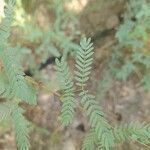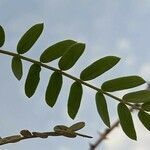Tree or shrub to 6.5 m high; prickles internodal, scattered, straight and somewhat acroscopic. Pinnae 1-3 pairs; leaflets 7-14 pairs per pinna, 4-15 by 2-4.5 mm. Pod slender, elongate, 8-19 by 0 4 0 7 cm, subcylindric-torulose. Seeds distant, ovoid c 6 mm long.


